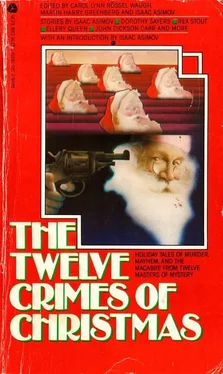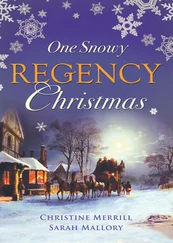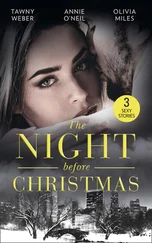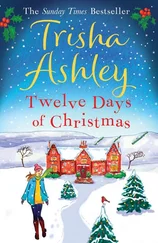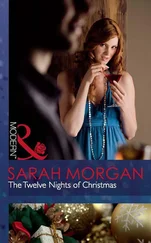Carol-Lynn Waugh - The Twelve Crimes of Christmas
Здесь есть возможность читать онлайн «Carol-Lynn Waugh - The Twelve Crimes of Christmas» весь текст электронной книги совершенно бесплатно (целиком полную версию без сокращений). В некоторых случаях можно слушать аудио, скачать через торрент в формате fb2 и присутствует краткое содержание. Жанр: Триллер, на английском языке. Описание произведения, (предисловие) а так же отзывы посетителей доступны на портале библиотеки ЛибКат.
- Название:The Twelve Crimes of Christmas
- Автор:
- Жанр:
- Год:неизвестен
- ISBN:нет данных
- Рейтинг книги:3 / 5. Голосов: 1
-
Избранное:Добавить в избранное
- Отзывы:
-
Ваша оценка:
- 60
- 1
- 2
- 3
- 4
- 5
The Twelve Crimes of Christmas: краткое содержание, описание и аннотация
Предлагаем к чтению аннотацию, описание, краткое содержание или предисловие (зависит от того, что написал сам автор книги «The Twelve Crimes of Christmas»). Если вы не нашли необходимую информацию о книге — напишите в комментариях, мы постараемся отыскать её.
The Twelve Crimes of Christmas — читать онлайн бесплатно полную книгу (весь текст) целиком
Ниже представлен текст книги, разбитый по страницам. Система сохранения места последней прочитанной страницы, позволяет с удобством читать онлайн бесплатно книгу «The Twelve Crimes of Christmas», без необходимости каждый раз заново искать на чём Вы остановились. Поставьте закладку, и сможете в любой момент перейти на страницу, на которой закончили чтение.
Интервал:
Закладка:
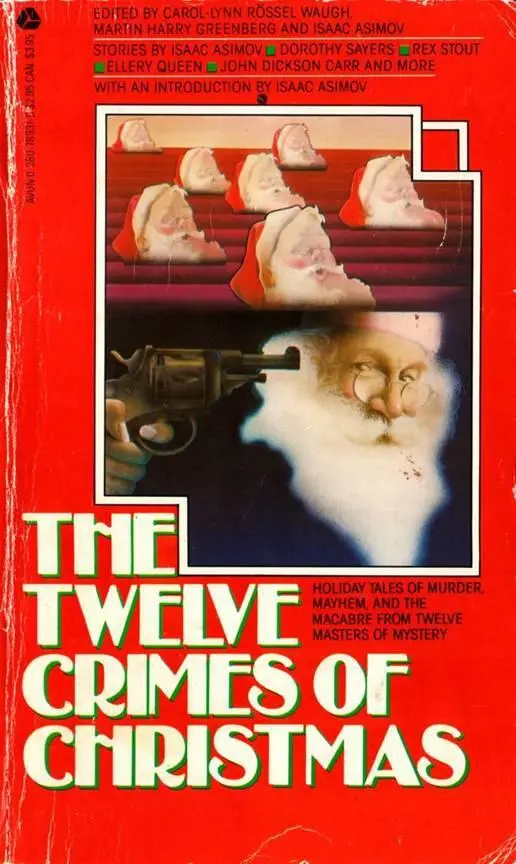
Carol-Lynn Rössel Waugh, Martin H Greenberg, Isaac Asimov, Rex Stout, Robert Somerlott, Dorothy L. Sayers, Alice Scanlan Reach, S. S. Rafferty, Ellery Queen, Nick O’Donohoe, Edward D. Hoch, Stanley Ellin, August Derleth, John Dickson Carr
The Twelve Crimes of Christmas
An anthology of stories
© 1981 by Nightfall, Inc., Carol-Lynn Rössel Waugh, and Martin Harry Greenberg
To Charles Gordon Waugh
C-L. R. W.,
M. H. G. and
I. A.
ACKNOWLEDGMENTS
“The Thirteenth Day of Christmas,” by Isaac Asimov. Copyright © 1977 by Isaac Asimov. First published in Ellery Queen’s Mystery Magazine. Reprinted by permission of the author.
“Blind Man’s Hood,” by John Dickson Carr. From The Department of Queer Complaints, by Carter Dickson. Copyright © 1940 by William Morrow and Company; renewed 1968 by John Dickson Carr. Reprinted by permission of the publishers.
“The Adventure of the Unique Dickensians,” by August Derleth. Copyright © 1968 by Arkham House Publishers, Inc. Reprinted by permission of Arkham House Publishers, Inc., Sauk City, Wisconsin.
“Death on Christmas Eve,” by Stanley Ellin. Copyright © 1950, 1978 by Stanley Ellin. First published in Ellery Queen’s Mystery Magazine. Reprinted by permission of Curtis Brown, Ltd.
“The Problem of the Christmas Steeple,” by Edward D. Hoch. Copyright © 1976 by Edward D. Hoch. First published in Ellery Queen’s Mystery Magazine. Reprinted by permission of Larry Sternig Literary Agency.
“By the Chimney with Care,” by Nick O’Donohoe. Copyright © 1978 by Renown Publications, Inc. First published in Mike Shayne’s Mystery Magazine. Reprinted by permission of Hintz Literary Agency.
“The Dauphin’s Doll,” by Ellery Queen. Copyright © 1948, 1951 by Ellery Queen; renewed. Reprinted by permission of the Scott Meredith Literary Agency, Inc., 845 Third Avenue, New York, N. Y. 10022.
“The Christmas Masque,” by S. S. Rafferty. Copyright © 1976 by S. S. Rafferty. First published in Ellery Queen’s Mystery Magazine. Reprinted by permission of the author.
“Father Crumlish Celebrates Christmas,” by Alice Scanlan Reach. Copyright © 1967 by Davis Publications, Inc. First published in Ellery Queen’s Mystery Magazine. Reprinted by permission of Ann Elmo Agency, Inc.
“The Necklace of Pearls,” by Dorothy L. Sayers. From Lord Peter, by Dorothy L. Sayers. Copyright © 1933 by Dorothy Leigh Sayers Fleming; renewed 1961 by Lloyds Bank Ltd., Executors. Reprinted by permission of Harper & Row, Publishers, Inc.
“Do Your Christmas Shoplifting Early,” by Robert Somerlott. Copyright © 1965 by Davis Publications, Inc. First published in Ellery Queen’s Mystery Magazine. Reprinted by permission of McIntosh and Otis, Inc.
“Christmas Party,” by Rex Stout. From And Four to Go, by Rex Stout. Copyright © 1956, 1957 by Rex Stout. Reprinted by permission of Viking Penguin, Inc.
Introduction: NOEL, NOEL! by Isaac Asimov
Throughout the North Temperate zone (in which western civilization arose and matured), there is always a reminder in the sky that things will not last.
All through the summer and fall, when the world is smiling and green things are growing and harvests are collected and stored, the Sun marks out a path in the sky that each day is lower toward the southern horizon than on the day before. The lower the sun is, the less intense is its warmth and the shorter the days get, so that the less-intense warmth has ever less time to do its job.
This is a sobering reminder in the very midst of prosperity that winter is coming, a time of dreary cold and of the apparent death of the plant world.
Yet the decline of the Sun slows and finally there comes a time when the Sun halts its southward drop altogether and then begins to mark out a higher and higher path each day than the day before. The weather continues cold for months after the Sun starts its rise, but that rise is a portent and a promise in the midst of decay that the winter will not last forever and that spring is coming, and with it a renewal of warmth and life and happiness.
We know exactly what causes this. We know about the Earth’s tipped axis and how it affects the Sun’s apparent path in the sky in the course of the Earth’s annual revolution about its luminary.
Primitive man did not know this, however, nor did he have any concept of the Sun being kept on course by the inexorability of celestial mechanics. He felt the fall and rise of the Sun to be the work of all-powerful gods, who acted out of obscure motives of their own, either in whimsical benevolence or petulant anger.
In short, primitive man could never be sure that the Sun would not, on this occasion, continue its weary decline until it disappeared forever beyond the southern horizon, leaving Earth to eternal winter and death.
Consequently, on or about the time when the Sun halts in its southern flight and begins its climb back to warmth and life (this turning point-the “winter solstice”-comes on December 21, by our calendar), there is a vast outpouring of relief. It is natural that the time be celebrated with grand festivals and merrymaking.
To the Romans, Saturn was the god of the spring planting and was eventually viewed as being in charge of agriculture generally. When the Sun made its turn, therefore, and there was the promise of successful spring planting to come, the Romans considered it the result of Saturn’s benevolent care in setting a limit to the Solar decline. Their winter solstice festival was thus in his honor and was called the “Saturnalia.”
It was the happiest and most popular of all the Roman festivals and it was eventually extended to seven days in length, running from December 17 to December 24. It was a time of unrestrained gaiety and feasting; public offices, businesses, schools were all closed in its honor; servants and slaves were allowed a period of relative freedom in which they might mingle with their masters in mutual bonhomie; gifts were exchanged. Such was the all-round benevolence of the time that a little sexual license was winked at. (It was this last that incurred the wrath of moralists and has caused “saturnalian” to refer to anything marked by orgies of drink and sex.)
By the third century of our era, however, the Roman gods were moribund, and eastern religions more and more swayed the hearts and minds of Roman citizens. Yet one aspect of the old religion remained untouchable, and that was the Saturnalia. Whatever else of their old ways the peoples of the Roman Empire were willing to give up, the Saturnalia had to remain.
The most prominent of the new religions was, for a time, Mithraism, which was a form of Sun worship. Mithraists saw in the fall and rise of the Sun the promise that after man’s death there would come a glorious resurrection. The Saturnalia suited them, therefore, and they added to it a climactic day of their own. On December 25, the day after the conclusion of the Saturnalia, the Mithraists celebrated the birth of Mithra, the symbolic representation of the light of the Sun. This great “day of the invincible Sun” was the most popular aspect of Mithraism.
The Mithraists made the major mistake, however, of excluding women from their religious rituals. The rival religion of Christianity wisely included women, which insured that while many fathers were Mithraists, many mothers were Christians, and the children were far more apt to follow their mothers’ early teachings than their fathers’ later ones.
Читать дальшеИнтервал:
Закладка:
Похожие книги на «The Twelve Crimes of Christmas»
Представляем Вашему вниманию похожие книги на «The Twelve Crimes of Christmas» списком для выбора. Мы отобрали схожую по названию и смыслу литературу в надежде предоставить читателям больше вариантов отыскать новые, интересные, ещё непрочитанные произведения.
Обсуждение, отзывы о книге «The Twelve Crimes of Christmas» и просто собственные мнения читателей. Оставьте ваши комментарии, напишите, что Вы думаете о произведении, его смысле или главных героях. Укажите что конкретно понравилось, а что нет, и почему Вы так считаете.
